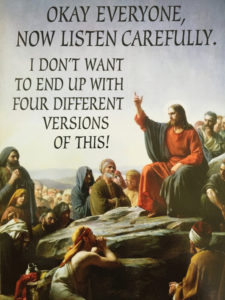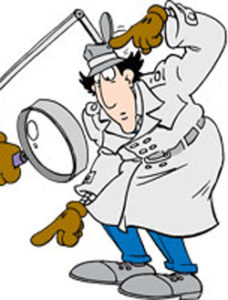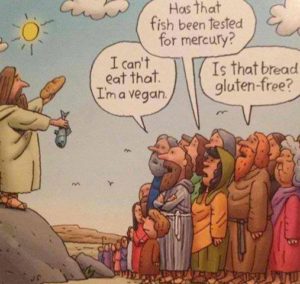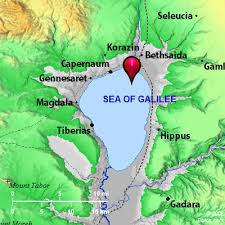Is the feeding of the 5000 historical? – by Kevin Rogers
March 25, 2018
1 Introduction
1.1 The 4 gospels
The New Testament starts with the 4 gospels: Matthew, Mark Luke and John. Each gospel also provides unique material. For example, only Luke gives us the parable of the prodigal son and only Matthew tells us about the visit by the Magi, but, some material is repeated. I have sometimes reacted, “Ho hum, boring! I have heard this all before”, but I was wrong.
This repeated material is a great opportunity for discovering some really interesting stuff. It is very helpful to have 4 gospels as we have 4 witnesses to the life of Jesus.
1.2 Vertically and Horizontally
There are different ways that we can read the gospels. Two ways are reading the gospels are vertically and horizontally.
Reading the gospels vertically is reading each gospel individually from start to end and then perhaps going on to the next one. This is the normal way that we read the gospels and is the way they were meant to be read. Each gospel writer has something unique to say and so they have woven all of their accounts in such a sequence as to support their unique perspective. So, if you read the gospels this way, be encouraged, you are doing the right thing.
Reading horizontally means comparing how each gospel writer tells the same story. Often much of it is very similar, sometimes identically word for word, but there are also differences. Some of these differences may look like contradictions and sometimes the differences may be additional material or different perspectives on the same thing.
1.3 Un-designed coincidences
One of the features of the four gospels is that each writer provides independent details that interlock with the other gospel writers. This is the type of evidence that detectives and lawyers look for to identify genuine eye-witness accounts. This type of evidence is called “Un-designed Coincidences”. There are many examples but I will illustrate it with just one event.
2 Gospel accounts of the feeding of the 5000
The feeding of the 5000 is one of the few miracles or events that are reported in all 4 gospels, where Jesus feeds over 5000 people from 5 loaves of bread and 2 fish.
This would immediately prompt sceptics to dismiss this report as a complete fable, but there are elements to these reports that are very intriguing. There are many strong similarities, but each also contains subtle independent differences. I have highlighted those differences that are relevant to my argument. The texts are as follows:
2.1 Mark 6:30-44
The earliest description is from the gospel of Mark:
30 The apostles returned to Jesus and told him all that they had done and taught. 31 And he said to them, “Come away by yourselves to a desolate place and rest a while.” For many were coming and going, and they had no leisure even to eat. 32 And they went away in the boat to a desolate place by themselves. 33 Now many saw them going and recognized them, and they ran there on foot from all the towns and got there ahead of them. 34 When he went ashore he saw a great crowd, and he had compassion on them, because they were like sheep without a shepherd. And he began to teach them many things. 35 And when it grew late, his disciples came to him and said, “This is a desolate place, and the hour is now late. 36 Send them away to go into the surrounding countryside and villages and buy themselves something to eat.” 37 But he answered them, “You give them something to eat.” And they said to him, “Shall we go and buy two hundred denarii worth of bread and give it to them to eat?” 38 And he said to them, “How many loaves do you have? Go and see.” And when they had found out, they said, “Five, and two fish.” 39 Then he commanded them all to sit down in groups on the green grass. 40 So they sat down in groups, by hundreds and by fifties. 41 And taking the five loaves and the two fish, he looked up to heaven and said a blessing and broke the loaves and gave them to the disciples to set before the people. And he divided the two fish among them all. 42 And they all ate and were satisfied. 43 And they took up twelve baskets full of broken pieces and of the fish. 44 And those who ate the loaves were five thousand men.
2.2 Matthew 14:13-21
Matthew’s account is as follows:
Now when Jesus heard this, he withdrew from there in a boat to a desolate place by himself. But when the crowds heard it, they followed him on foot from the towns. 14 When he went ashore he saw a great crowd, and he had compassion on them and healed their sick. 15 Now when it was evening, the disciples came to him and said, “This is a desolate place, and the day is now over; send the crowds away to go into the villages and buy food for themselves.” 16 But Jesus said, “They need not go away; you give them something to eat.” 17 They said to him, “We have only five loaves here and two fish.” 18 And he said, “Bring them here to me.” 19 Then he ordered the crowds to sit down on the grass, and taking the five loaves and the two fish, he looked up to heaven and said a blessing. Then he broke the loaves and gave them to the disciples, and the disciples gave them to the crowds. 20 And they all ate and were satisfied. And they took up twelve baskets full of the broken pieces left over. 21 And those who ate were about five thousand men, besides women and children.
Mathew’s account is very similar to Mark’s but he omits the size of the groups that sat down.
2.3 Luke 9:10-17
Luke’s account is:
10 On their return the apostles told him all that they had done. And he took them and withdrew apart to a town called Bethsaida. 11 When the crowds learned it, they followed him, and he welcomed them and spoke to them of the kingdom of God and cured those who had need of healing. 12 Now the day began to wear away, and the twelve came and said to him, “Send the crowd away to go into the surrounding villages and countryside to find lodging and get provisions, for we are here in a desolate place.” 13 But he said to them, “You give them something to eat.” They said, “We have no more than five loaves and two fish—unless we are to go and buy food for all these people.” 14 For there were about five thousand men. And he said to his disciples, “Have them sit down in groups of about fifty each.” 15 And they did so, and had them all sit down. 16 And taking the five loaves and the two fish, he looked up to heaven and said a blessing over them. Then he broke the loaves and gave them to the disciples to set before the crowd. 17 And they all ate and were satisfied. And what was left over was picked up, twelve baskets of broken pieces.
Luke states that the event took place at Bethsaida, but does not mention the grass.
2.4 John 6:1-14
John’s account has a number of distinct features:
After this Jesus went away to the other side of the Sea of Galilee, which is the Sea of Tiberias. 2 And a large crowd was following him, because they saw the signs that he was doing on the sick. 3 Jesus went up on the mountain, and there he sat down with his disciples. 4 Now the Passover, the feast of the Jews, was at hand. 5 Lifting up his eyes, then, and seeing that a large crowd was coming toward him, Jesus said to Philip, “Where are we to buy bread, so that these people may eat?” 6 He said this to test him, for he himself knew what he would do. 7 Philip answered him, “Two hundred denarii worth of bread would not be enough for each of them to get a little.” 8 One of his disciples, Andrew, Simon Peter’s brother, said to him, 9 “There is a boy here who has five barley loaves and two fish, but what are they for so many?” 10 Jesus said, “Have the people sit down.” Now there was much grass in the place. So the men sat down, about five thousand in number. 11 Jesus then took the loaves, and when he had given thanks, he distributed them to those who were seated. So also the fish, as much as they wanted. 12 And when they had eaten their fill, he told his disciples, “Gather up the leftover fragments, that nothing may be lost.” 13 So they gathered them up and filled twelve baskets with fragments from the five barley loaves left by those who had eaten. 14 When the people saw the sign that he had done, they said, “This is indeed the Prophet who is to come into the world!”
John mentions the mountain, the Passover, the question being specifically to Philip and the boy.
3 The argument
The highlighted differences indicate corroboration without collaboration.
3.1 The green, green grass
Matthew, Mark and John all state that the people sat on the grass. Mark says that the grass was green and John says that there was much grass. John states that the event occurred at the time of the Passover (April). Mark says that many were coming and going, which is characteristic of the Passover when there were many visitors to Jerusalem. Indeed Josephus (2014, Book VI, Chapter 9, Paragraph 3) claims there were nearly 3 million Jews in Jerusalem for the Passover in 65 AD. It was probably an exaggeration, but there were a lot of people travelling to Jerusalem at that time. The main travelling routes were on the western side of Lake Galilee in the region of Capernaum.
Galilee has a Mediterranean climate, like South Australia, only worse. It mainly rains in winter and the summers are hot and dry, when there is little grass. The grass is rarely green in Galilee but it is usually greenest in spring after the summer rains at the time of the Passover. By contrast, for the later feeding of the 4000 the people sat on the ground (Mark 8:6 & Matthew 15:35), rather than on the grass.
So all 4 accounts independently confirm that the feeding of the 5000 occurred in spring at the time of the Passover when the grass is green.
3.2 Who sat down?
All gospels state that there were about 5000 men. Only Matthew adds the seemingly patriarchal disclaimer “besides women and children”. Is this just some sexist aside, or does it have some significance? All gospels record that Jesus commanded the people to sit down. Mark says in groups of 100s and 50s and Luke says that the groups were about 50 each. However, John says that only the men actually sat down. So, the men probably sat down to distribute the food and so they were easily counted while the children were up and playing and the women were supervising them. So all 4 gospels corroborate each other:
- Luke and Mark state that the crowd sat down in groups of 50 (or 100).
- John states that only the men sat down, and that is why only the men were counted.
- Matthew states that there were 5000 men not counting women and children.
3.3 The mountain
Only John mentions that the feeding of the 5000 occurred on a mountain: “Jesus went up on the mountain” (John 6:3). None of the other gospels mentions that it was on a mountain in their direct descriptions of the event. However, Mark and Matthew mention it incidentally immediately afterwards, “Immediately he made the disciples get into the boat and go before him to the other side, while he dismissed the crowds. And after he had dismissed the crowds, he went up on the mountain by himself to pray.” (Matt 15:22.23). Matthew and Mark do not explicitly say that the event occurred on the mountain, but they do confirm that the mountain was at least nearby.
3.4 Why did Jesus ask Philip?
Matthew, Mark & Luke all record Jesus as saying “You give them something to eat”, but only in John does Jesus address this specifically to Philip. Why Philip? He is a minor disciple.
Independently of the feeding of the 5000, John states (twice) that Philip was from Bethsaida:
- Now Philip was from Bethsaida, the city of Andrew and Peter (John 1:44)
- Now among those who went up to worship at the feast were some Greeks. So these came to Philip, who was from Bethsaida in Galilee, and asked him, “Sir, we wish to see Jesus.” (John 12:20,21)
John says that Philip (like Peter and Andrew) was from Bethsaida, but only Luke records that the feeding of the 5000 occurred at Bethsaida. So Luke makes sense of John. Jesus picked on Philip because it was Philip’s hometown region. Jesus was in effect asking him “Where is the local fish and chip shop?”
There is a problem about Bethsaida though. After the event Mark states, “Immediately he made his disciples get into the boat and go before him to the other side, to Bethsaida, while he dismissed the crowd.” (Mark 6:45). So Mark appears to be contradicting Luke. In Mark the event that follows is the walking on water incident. However, when Jesus and the disciples arrive on the shore, it is not at Bethsaida (which is on the North eastern shore just east of where the Jordon enters Lake Galilee), but at Gennesaret, which is on the western side of Lake Galilee near Capernaum. So the arrival location tallies more with the other accounts.
In actual fact, ““to Bethsaida” is a translation of “pros Beethsaidan”, but “pros” is a preposition of direction; forward to, i.e. toward. So it could be translated “towards Bethsaida”. This may just a translation issue. The event took place in a desolate place near Bethsaida. When the disciples returned , by boat they initially went towards Bethsaida, but eventually arrived on the western side of the lake near Gennesaret and Capernaum.
3.5 Bethsaida
There are also some interesting statements about Bethsaida. Only Matthew and Luke report Jesus pronouncing woes on Bethsaida for not responding properly to the mighty works performed in that city
Matthew 11:21 “Woe to you, Chorazin! Woe to you, Bethsaida! For if the mighty works done in you had been done in Tyre and Sidon, they would have repented long ago in sackcloth and ashes.
Luke 10:13 “Woe to you, Chorazin! Woe to you, Bethsaida! For if the mighty works done in you had been done in Tyre and Sidon, they would have repented long ago, sitting in sackcloth and ashes.
Both Matthew and Luke record Jesus as declaring woes on Bethsaida and Chorazin for not repenting in response to the mighty works performed in those towns, but Matthew makes no other mention of Bethsaida in his whole gospel, so why did Matthew single out Bethsaida and Chorazin for so much condemnation?
However, Luke says that the feeding of the 5000 occurred in Bethsaida. In addition, Mark reports the healing of a blind man in Bethsaida:
And they came to Bethsaida. And some people brought to him a blind man and begged him to touch him. And he took the blind man by the hand and led him out of the village, and when he had spit on his eyes and laid his hands on him, he asked him, “Do you see anything?” And he looked up and said, “I see people, but they look like trees, walking.” Then Jesus laid his hands on his eyes again; and he opened his eyes, his sight was restored, and he saw everything clearly. And he sent him to his home, saying, “Do not even enter the village.” (Mark 6:22-26)
So both Luke and Mark incidentally support Matthew’s statement by mentioning some of the mighty works that Jesus performed in Bethsaida. But what about Chorazin? Chorazin is otherwise not mentioned anywhere in the gospels. What does this indicate? There is no sinister plot to bolster Jesus’ woe. This strongly confirms that Jesus did declare the woe and that he performed mighty works in Bethsaida.
4 Conclusion
The 4 gospels mention incidental independent details that explain each other in a non-contrived way (without collaboration). It doesn’t happen for all incidental information, as these cross-couplings are accidental. Sometimes they are there and sometimes they are not. All of this is characteristic of reports of historical events that were based on eye-witness accounts. It happens because the various witnesses record different features that stuck in their minds. This does not happen in the forged gospels but is only a property of the 4 canonical gospels.
I am not claiming that this proves that Jesus performed a miracle, but the independent interlocking details seem to strongly confirm that the feeding of the 5000 was based on at least some historical event.
This is only one example, which you could put down to chance, if you are that way inclined, but there are many others. They are not immediately obvious and can be hard to find, but they are there for those who are willing to look. So seek and you will find.
This is a summary of the talk given at Reasonable Faith Adelaide on Thursday, 8 March 2018. Hopefully, a video of the talk will be uploaded to our You Tube site in the near future. It was presented by Kevin Rogers, Director, Reasonable Faith Adelaide
5 References
Josephus, F. (2014). The War of the Jews (Simon and Schuster).




